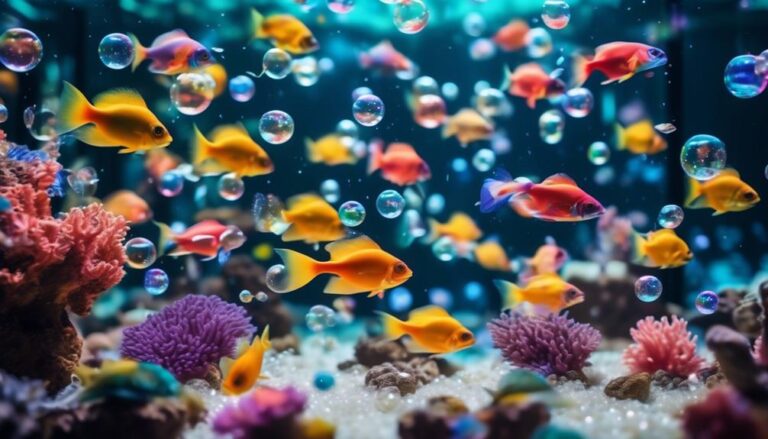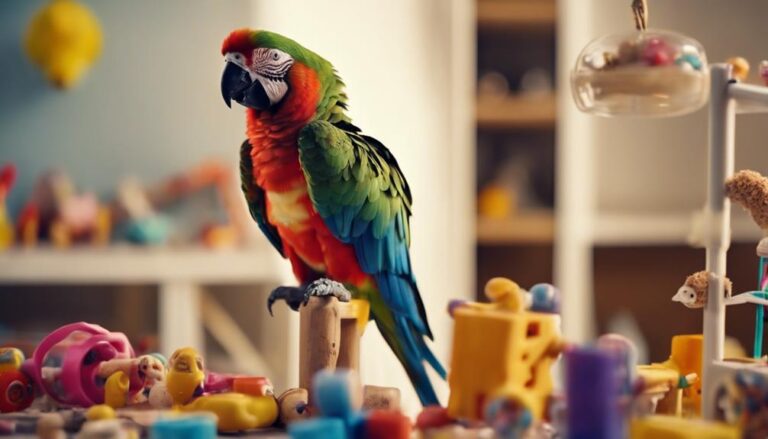A Beginner’s Guide To Keeping An Aquarium Clean And Healthy

A Beginner’s Guide To Keeping An Aquarium Clean And Healthy: So, you’ve taken the plunge and decided to embark on the rewarding journey of fishkeeping. Congratulations! Now, let’s talk about the importance of maintaining a clean and healthy environment for your aquatic friends. It’s no secret that a well-maintained aquarium is crucial for the well-being of your fish, and we’re here to guide you through the process. But before we dive into the nitty-gritty details, there’s something you need to know that will make all the difference in the world.
Tank Size Matters
Choosing the appropriate tank size is crucial for maintaining a clean and healthy aquarium environment for your pet fish. Adequate space is essential to ensure that your fish can thrive and live comfortably. When selecting a tank size, it is important to consider the number of fish you plan to have. Overcrowding the tank can lead to poor water quality, low oxygen levels, and increased risk of disease.
Bigger tanks provide more room for fish to swim and explore, which leads to a healthier underwater environment. The larger the tank, the more stable the water conditions will be. This is because larger volumes of water are more forgiving when it comes to changes in temperature, pH levels, and ammonia levels. Additionally, larger tanks have a greater capacity to accommodate filtration systems, which are necessary for maintaining water quality.
To determine the right tank size for your pet fish, it is advisable to consult with pet counselors who have expertise in aquarium care. They can assess the specific needs of your fish species and provide recommendations based on their size, behavior, and growth potential. It is important to remember that different fish species have different space requirements, so proper research is essential.
Choosing the Right Equipment
To ensure the optimal functioning and health of your aquarium, it is essential to carefully select the appropriate equipment. The first piece of equipment you should consider is a reliable filter system. A popular choice is the Whisper EX Series Filtration Systems, known for their efficiency in removing debris and keeping the water clean. The filter system plays a crucial role in maintaining the overall water quality in the tank. It helps remove harmful substances such as ammonia and nitrites, which can be detrimental to the health of your fish.
In addition to the filter system, you should also invest in a heater to maintain the right temperature for your fish. Different species of fish have varying temperature requirements, so it is important to research and set the temperature accordingly. The heater should be able to maintain a stable temperature range to keep your fish comfortable and healthy.
Furthermore, an air pump is another valuable piece of equipment to consider. It provides extra oxygen to the tank, ensuring that your fish have a sufficient supply for respiration. This is particularly important in tanks with a high fish population or in tanks with live plants, as they consume oxygen and release carbon dioxide.
Proper lighting is also essential for your aquarium. Fish require a regular day and night cycle, so it is recommended to provide them with 8-12 hours of light each day. This can be achieved through fluorescent or LED lights specifically designed for aquarium use.
To monitor the water temperature accurately, use a thermometer designed for aquariums. This will allow you to make adjustments as needed to maintain the ideal temperature for your fish.
Maintaining Water Quality
Regularly testing the water quality is crucial to maintaining a clean and healthy aquarium environment. By monitoring parameters such as pH, ammonia, nitrite, and nitrate levels, you can ensure that the water conditions are suitable for your fish. Testing kits are readily available and easy to use, allowing you to quickly assess the water quality.
In addition to regular testing, performing partial water changes is essential for maintaining an aquarium. These water changes help remove accumulated nitrates and other waste products, ensuring a healthy living environment for your fish. It is recommended to change approximately 10-20% of the water every one to two weeks. This will help dilute any toxins and maintain stable water conditions.
When conducting water changes, it is crucial to treat tap water with a de-chlorinator before adding it to the aquarium. This removes harmful chlorine or chloramine, which can be detrimental to the health of your fish. Follow the instructions on the dechlorinator bottle for proper dosage.
While maintaining the water quality, it is equally important to keep the filter clean. Replace filter cartridges every 2-4 weeks, as they can become clogged with debris and lose their effectiveness. Additionally, vacuuming the gravel regularly helps remove waste buildup and keeps the substrate clean.
During aquarium maintenance tasks, always prioritize safety. Use dedicated equipment for aquarium maintenance and avoid using the same equipment for other purposes. Unplug any electricals before performing any maintenance to prevent accidents. By following these steps, you can maintain optimal water quality and ensure a clean and healthy environment for your aquarium inhabitants.
Establishing a Cleaning Routine
To establish a thorough cleaning routine for your aquarium, it is essential to perform regular water changes and maintain proper water parameters. Cleaning the tank regularly is crucial for maintaining a clean and healthy environment for your aquatic pets. By removing accumulated waste and debris, you can prevent the buildup of harmful substances that can negatively impact water quality.
Performing water changes on a regular basis is a fundamental part of establishing a cleaning routine. This process involves removing a portion of the water and replacing it with fresh, dechlorinated water. Water changes help to eliminate toxins, excess nutrients, and waste products that can accumulate over time. It is recommended to change 10-20% of the water every one to two weeks, depending on the size of your aquarium and the number of fish.
In addition to water changes, it is crucial to monitor and maintain proper water parameters. Use water testing kits to regularly check the levels of ammonia, nitrite, nitrate, pH, and other essential parameters. This will help you identify any imbalances or issues in the water chemistry and take necessary corrective measures.
To establish a cleaning routine, it is advisable to invest in essential cleaning supplies. Algae scrubbers, toothbrushes, and pruning tools can assist in cleaning the tank glass, decorations, and structures. Regularly removing algae and waste from these surfaces will prevent excessive buildup and maintain a visually appealing aquarium.
Follow a step-by-step cleaning process to ensure thoroughness and efficiency. Start by testing the water quality, then remove any visible algae using an algae scrubber or a toothbrush. Prune any overgrown plants to maintain their health and appearance. Lastly, vacuum the substrate to remove any accumulated debris. By following these steps and maintaining a regular cleaning routine, you can ensure a clean and healthy environment for your aquarium inhabitants.
Proper Feeding Techniques
Feeding your aquarium fish appropriately is essential for their overall health and well-being. To keep the water clean and maintain optimal conditions for your fish, it is important to follow proper feeding techniques.
First, it is crucial to feed your fish small amounts of food at a time. This prevents overfeeding and the subsequent contamination of the water. Only provide what your fish can consume within a few minutes. Research the specific dietary needs of your fish species to ensure a balanced diet. This may include a combination of pellets, flakes, and occasional live or frozen food.
Consider incorporating a fasting day into your fish’s feeding routine. This allows their digestive system to rest and helps prevent overfeeding issues. Monitoring your fish during feeding is also important. Ensure that all fish are eating and adjust the amount of food accordingly to avoid overfeeding or underfeeding.
After a few minutes, remove any uneaten food from the aquarium. This helps maintain water quality and prevents the buildup of waste. Uneaten food can decompose and release harmful substances into the water, negatively impacting the health of your fish.
Monitoring Temperature and Lighting
To ensure the overall health and well-being of your aquarium fish, it is essential to closely monitor the temperature and lighting conditions of their aquatic environment. Maintaining the ideal water temperature is crucial for the survival of your fish. Use a reliable thermometer to regularly check the water temperature and ensure it stays within the recommended range. Most tropical fish thrive in temperatures between 75-82 degrees Fahrenheit (23-28 degrees Celsius). However, it is important to note that different fish species may have specific temperature requirements, so it is necessary to research and adjust accordingly.
Proper lighting is also vital for your aquarium’s ecosystem. Providing 8-12 hours of light each day mimics the natural day-night cycle, promoting plant growth and creating a harmonious environment for your fish. Consider the specific lighting needs of your aquarium plants and fish species to maintain a healthy balance. Some plants may require higher light intensity, while others may thrive with lower levels. It is crucial to choose the appropriate aquarium light that provides the necessary spectrum and intensity for your plants to photosynthesize effectively.
Regularly monitoring and maintaining the temperature and lighting conditions in your aquarium are crucial tasks. Fluctuations in temperature can stress or even harm your fish, while inadequate lighting can hinder plant growth and disrupt the overall balance of the ecosystem. Ensure that the temperature remains constant and within the recommended range by using a heater or chiller if necessary. Additionally, regularly clean the aquarium light to remove any dust or algae buildup that may hinder its effectiveness.
Managing Algae Growth
To effectively manage algae growth in your aquarium, there are several key techniques to consider. First, you need to balance the lighting and nutrient levels in the tank. By monitoring and maintaining consistent lighting levels, you can prevent excessive algae growth. Additionally, implementing proper water circulation and filtration systems will help control nutrient levels and reduce the growth of algae. Regular cleaning and the use of algae control products, along with avoiding overfeeding your fish, will further help keep algae growth in check.
Algae Prevention Techniques
Regular maintenance and proper management of water conditions are essential in preventing excessive algae growth in your aquarium. One of the key techniques to prevent algae is to perform regular water changes. By replacing a portion of the water, you can remove excess nutrients that contribute to algae growth. Additionally, proper waste management is crucial. Excess fish food and organic waste can release nutrients into the water, fueling algae growth. Be sure to remove any uneaten food and clean the substrate regularly. Another effective technique is to maintain proper lighting and nutrient levels. Algae thrive in high-light and nutrient-rich environments, so it is important to strike a balance.
Consider using a timer to regulate the duration and intensity of light exposure. Lastly, adding algae-eating fish or invertebrates can help keep algae in check. Species such as snails or shrimp are natural grazers and can help control algae growth. By implementing these algae prevention techniques, you can keep your aquarium clean and healthy.
Balance Lighting and Nutrients
Maintain a well-balanced aquarium ecosystem by carefully managing the lighting duration and nutrient levels to effectively control algae growth. In order to prevent algae overgrowth, it is important to ensure appropriate lighting duration of 8-12 hours per day. Using a timer can help maintain consistent lighting schedules, which are essential for both plant growth and algae control. Additionally, it is crucial to balance the nutrients in the aquarium. This includes maintaining optimal levels of CO2, iron, and potassium to support healthy growth of aquatic plants, while limiting excess nutrients that can fuel algae growth.
Consider introducing floating plants or algae-eating organisms to naturally manage algae growth. Regularly cleaning light fixtures and replacing bulbs as needed will also help maintain optimal lighting conditions for the aquarium ecosystem. By carefully balancing lighting and nutrients, you can effectively control algae growth and maintain a clean and healthy aquarium environment.
Regular Cleaning Schedule
By implementing a regular cleaning schedule, you can effectively manage algae growth in your aquarium and maintain a clean and healthy tank environment. Regularly cleaning the tank glass and structures is essential to prevent excessive algae buildup. Monitor and control algae growth using recommended methods to ensure a balanced tank ecosystem.
Factors such as tank size, fish population, and biological filtration should be considered when determining the frequency of cleaning to manage algae growth effectively. It is unnecessary to remove fish from the tank during cleaning, as leaving them in reduces the stress caused by catching and handling. To effectively remove algae from tank walls and decor, use necessary cleaning supplies such as an algae scrubber and toothbrush. By following a regular cleaning schedule, you can keep your aquarium clean and create a healthy environment for your fish.
Pruning and Caring for Plants
To ensure the health and vitality of your aquarium plants, proper pruning techniques are essential. Regularly trimming off dead or decaying leaves will help prevent the spread of diseases and maintain water quality. Additionally, it is important to provide adequate care for your plants, including proper lighting, fertilization, and CO2 supplementation, to promote healthy growth and vibrant colors.
Plant Pruning Techniques
Regular pruning is essential for maintaining the shape and health of your plants in the aquarium. To ensure proper pruning, make sure to use clean, sharp scissors or pruning shears to avoid damaging the plant. Start by removing dead or yellowing leaves, as they can detract from the overall appearance and health of the plant. This will also promote new growth in the aquarium.
Additionally, trim overgrown stems to encourage bushier growth and prevent legginess. By pruning off any diseased or damaged parts of the plant, you can prevent the spread of diseases and promote recovery. Remember to always make sure the aquarium water is free from any debris or plant clippings after pruning to maintain a clean and healthy environment for your live plants.
Essential Plant Care
After ensuring proper pruning techniques, the next step in maintaining a clean and healthy aquarium is to focus on essential plant care, specifically the pruning and caring for plants. Regular pruning and trimming of plants is necessary to promote healthy growth and prevent overcrowding in the aquarium. This helps maintain water quality and prevent the spread of disease by removing any dead or decaying plant matter.
It is important to monitor and maintain proper lighting and nutrient levels to support plant growth and vitality. Using appropriate tools such as aquarium scissors and tweezers ensures precision when pruning and planting new vegetation. Additionally, it is crucial to consider the specific needs of individual plant species, such as trimming floating plants to prevent excessive shading. Lastly, maintaining a constant water temperature promotes the overall well-being of real plants and encourages the growth of beneficial bacteria.
Cleaning the Substrate
Consider incorporating live plants into your substrate to help maintain a balanced environment by regulating biochemicals and providing essential nutrients for your aquarium. The substrate, typically made of gravel, plays a crucial role in the overall health and cleanliness of your aquatic ecosystem. It serves as a home for beneficial bacteria that break down fish waste and excess food, preventing harmful ammonia and nitrite levels from rising. Additionally, the gravel gives your fish a place to swim and explore, mimicking their natural habitat.
To clean the substrate effectively, you can use a gravel washer. This tool allows you to remove debris and waste buildup from the gravel without disturbing the beneficial bacteria and plant roots. By gently agitating the gravel, you can loosen any trapped waste, which can then be easily removed through siphoning. Regular vacuuming of the substrate is essential to maintain water quality and remove excess nitrates, which can be harmful to fish if allowed to accumulate.
While cleaning the substrate, it is crucial to monitor for any signs of anaerobic pockets or excessive debris accumulation. Anaerobic pockets can occur when organic matter becomes trapped in the substrate, leading to the production of toxic gases. If you notice any foul odors or unusual behavior from your fish, it may be an indication of anaerobic conditions that require immediate attention.
Remember to avoid disturbing the substrate too much during cleaning, as this can disrupt the beneficial bacteria and plant roots. By incorporating live plants into your substrate, you can further enhance the biological filtration process, as they absorb excess nutrients and provide oxygen to the aquarium. This helps to maintain water quality and reduce the frequency of substrate cleaning.
Regular Filter Maintenance
To ensure clean water and healthy fish, it is crucial to regularly maintain and clean your aquarium’s filter system. Regular filter maintenance is essential for a healthy aquarium and to keep your fish thriving. One important aspect of regular filter maintenance is replacing the filter cartridges every 2-4 weeks. This helps to maintain clean water by removing debris, waste, and other harmful substances that can accumulate in the filter. By replacing the cartridges regularly, you ensure that the filter is functioning optimally and providing the necessary filtration for your aquarium.
In addition to replacing the cartridges, performing regular water changes and vacuuming the gravel is also important. This helps to remove waste buildup and maintain the overall water quality. When performing these tasks, it is important to use dedicated buckets, sponges, and towels exclusively for aquarium maintenance to prevent contamination. This helps to ensure that no harmful substances or chemicals from other cleaning materials come into contact with the aquarium water.
Safety is also an important consideration during filter maintenance. Always remember to unplug the electrical equipment before performing any maintenance tasks. This not only protects the fish from possible electrical shocks but also ensures the safety of the person doing the maintenance.
Keeping an Eye on Fish Health
To ensure the health and well-being of your aquarium fish, it is essential to closely monitor their behavior and appearance. Observe for any signs of distress or illness, such as changes in color, lesions, or unusual behavior. Additionally, regularly check and maintain water quality parameters such as pH, ammonia, nitrite, and nitrate levels to create a healthy environment for your fish.
Monitoring Fish Behavior
Regularly observe and assess the swimming patterns, activity levels, appetite, weight, swimming behaviors, stress levels, aggression, physical changes, and overall health of your fish to ensure a clean and healthy aquarium environment. Monitoring fish behavior is crucial for maintaining the well-being of your fish. Start by observing their swimming patterns and overall activity levels on a daily basis.
Any changes in appetite or sudden weight loss should be noted, as they may indicate underlying health issues. Keep an eye out for abnormal swimming behaviors, such as swimming on their side or struggling to maintain balance, as these could be signs of illness or injury. Additionally, monitor for signs of stress or aggression among fish, such as hiding or fin nipping, as these behaviors can impact the overall health of your fish.
Lastly, look out for physical changes like discoloration, lesions, or unusual growths on the fish’s body, as these can also indicate health problems. By closely monitoring your fish’s behavior, you can address any issues promptly and maintain a clean and healthy fish tank. Remember to also provide them with clean and appropriate tap water to support their overall health and well-being.
Recognizing Common Diseases
Keeping a vigilant eye on the health of your fish is vital in recognizing common diseases and maintaining a healthy aquarium environment. By observing your fish closely, you can identify any symptoms that may indicate the presence of a disease. Look out for unusual swimming behavior, loss of appetite, or discoloration of the skin, as these are common signs of fish diseases.
Additionally, keep an eye out for specific indicators such as white spots (ich), fin rot, or cotton-like growth on the fish. Monitoring the tank for any sudden increase in fish deaths or unusual aggression among the fish is also crucial, as these could be signs of underlying health issues. Furthermore, pay attention to any changes in water quality, as poor water conditions can stress the fish and make them more susceptible to diseases. If you identify any symptoms, consult with a professional or refer to a reliable resource to promptly identify and treat the common fish diseases. This will ensure the overall health and well-being of your aquarium.
Maintaining Water Quality
By closely monitoring the behavior and appearance of your fish, you can ensure the ongoing health of your aquarium and maintain optimal water quality. Regularly checking for any signs of illness or distress is crucial in maintaining the well-being of your fish. Additionally, it is important to use water test kits to check for ammonia, nitrite, nitrate, and pH levels. These parameters can significantly affect the health of your fish, so it is necessary to keep them within the appropriate range.
Proper filtration and aeration are also essential in ensuring clean and oxygenated water for your fish. Performing regular water changes is crucial to remove accumulated waste and replenish essential nutrients. It is worth noting that tap water contains chemicals that can harm fish, so using a water conditioner is recommended. Lastly, gravel gives beneficial bacteria a surface to grow on, which aids in maintaining water quality. Seek advice from experts if you notice any changes in fish behavior or water quality.
A Beginner’s Guide To Keeping An Aquarium Clean And Healthy Frequently Asked Questions
How Do I Keep My Aquarium Water Clean and Healthy?
To keep your aquarium water clean and healthy, use effective filtration systems to remove impurities. Regularly test the water quality to ensure optimal conditions for your fish. Perform routine maintenance tasks, like water changes, to maintain a pristine aquatic environment.
How Do You Clean a Fish Tank for Beginners?
To clean a fish tank as a beginner, start by gathering the necessary cleaning equipment such as a gravel washer and a water conditioner. Perform weekly maintenance tasks like water changes and filter cartridge replacements. Troubleshoot common tank issues as needed.
How Do You Start a Healthy Aquarium?
To start a healthy aquarium, gather essential supplies like gravel, decorations, water conditioner, a net, gravel washer, and fish food. Choose the right location, add gravel, and fill with dechlorinated water. Carefully introduce fish while maintaining proper pH and chemical levels.
When Keeping an Aquarium What Is the Most Important Rule?
The most important rule in keeping an aquarium is maintaining water quality. This includes regular testing, proper filtration, and regular water changes. These steps ensure a healthy and thriving environment for your fish.
Conclusion
In conclusion, maintaining a clean and healthy aquarium requires careful attention to tank size, equipment selection, water quality, cleaning routines, feeding techniques, plant care, substrate cleaning, filter maintenance, and fish health monitoring. By following the guidelines provided in this comprehensive guide, beginners can create an optimal environment for their fish, ensuring their well-being and longevity. Remember, a clean and healthy aquarium is not only beneficial for the fish but also provides a visually appealing and enjoyable experience for the aquarium keeper.








